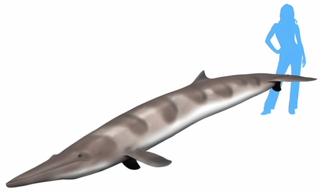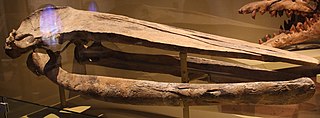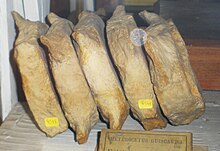
Ontocetus is an extinct genus of walrus, an aquatic carnivoran of the family Odobenidae, endemic to coastal regions of the southern North Sea and the southeastern coastal regions of the U.S. during the Miocene-Pleistocene. It lived from 13.6 mya—300,000 years ago, existing for approximately 13.3 million years.

Parietobalaena is an extinct genus of baleen whale, belonging to the family Pelocetidae. Fossils are found in Miocene-aged marine strata in North America, Europe, Australia and Japan.
Walter of Ghent was the second son of Hugues I and Odette de Champagne, daughter of Odo II of Champlitte. Hugues married Lady Avezoete, daughter of Abraham and perhaps of the house of Maelstede. Although his brother inherited the lordship of Heusden and Bornhem, he received the lordship of Sint Jansteen. He took the name Villain, a name synonymous with peasant or farm boy.

Xiphiacetus is an extinct genus of cetacean known from the Miocene (early Burdigalian to late Tortonian, 20.43 to 7.246 million years ago of Europe and the U.S. East Coast.
Mesocetus is an extinct genus of baleen whale from the Miocene of Europe.

Balaenula is an extinct genus of cetacean.

Balaenotus is an extinct genus of cetaceans from the Pliocene of Belgium.

Herpetocetus is a genus of cetotheriid mysticete in the subfamily Herpetocetinae.

Protororqualus is a genus of extinct rorqual from the late Pliocene of Mount Pulgnasco, Italy.
Plesiocetus is a genus of extinct balaenopterids found worldwide. It has had a chequered taxonomic history, having served as a wastebasket genus for a handful of mysticete species.

Cetotheriopsis is a genus of extinct cetaceans of the family Cetotheriopsidae.
Monotherium is an extinct genus of phocid belonging to the subfamily Monachinae. It is known from fossils found in the middle to late Miocene of Belgium.

Aglaocetus is a genus of extinct mysticete known from the Miocene of Patagonia, the US Eastern Seaboard, Japan and the Low Countries. It was once considered a member of Cetotheriidae along with many other putative cetotheres, but was recently recognized as representing a distinct family from true Cetotheriidae.
The following lists events that happened during 1884 in the Kingdom of Belgium.

Diplura lineata is a species of funnel-web tarantulas belonging to the subfamily Diplurinae. This species can be found in Venezuela and Brazil.
Nanophoca is an extinct genus of earless seals from the middle Miocene of Belgium.
Frisiphoca is an extinct genus of phocid belonging to the subfamily Phocinae. It is known from fossils found in the late Miocene of Belgium.
Eudelphis is an extinct genus of sperm whale belonging to Physeteroidea that lived in the ancient North Sea basin about 16-11 million years ago, during the middle Miocene (Langhian).
Events in the year 1877 in Belgium.

Octave van Rysselberghe was a Belgian architect of the Art Nouveau period. He is one of the representatives of the architectural renewal that characterized the end of the 19th century, with Victor Horta, Paul Hankar and Henry Van de Velde.











